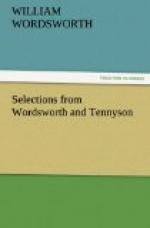5. CLOUDED NOONS. From the noons, which are still clouded.
6. PROPER. Own.
9. SPIRE. Flowering spikes.
10. SPEEDWELL. “The Germander Speedwell is a slender, wiry plant, whose stem sometimes creeps along the surface of the ground before it grows upwards. The flowers have four small petals of the brightest blue, and within the flower at the foot of the petals is a small white circle, with a little white eye looking up. Two stamens with crimson heads rise from this white circle, and in the very centre of the flower there is a tiny green seed-vessel, with a spike coming out of the top.”—C. B. Smith.
12. LABURNUMS.
“And all the gold from each laburnum
chain
Drops to the grass.” —To
Mary Boyle.
LXXXVI
“I can open my being also to the reviving influences of Nature—as on a certain evening, balmy and glorious after the rain, when the breeze seemed as if it might breathe new life, and waft me across the seas away from the land of doubt and death to some far off sphere of more than earthly peace,”—Arthur W. Robinson.
1. SWEET AFTER SHOWERS, ETC. This poem was written at Barmouth.
1. AMBROSIAL. Ambrosia was the food of the immortal gods. The wind was from the west and was “divinely reviving.”
4. BREATHING BARE. Making the horizon bare of clouds.
5. RAPT. Violent motion is not implied.
6. DEWY-TASSEL’D. From the showers.
7. HORNED FLOOD. Between two promontaries.
9. SIGH. “Impart as by a breath or sigh.”
10. NEW LIFE. Due to the new friendship.
11. DOUBT AND DEATH. These have up to this time haunted him.
13. FROM BELT, ETC. Tennyson explains: “The west wind rolling to the Eastern seas till it meets the evening star.”
16. WHISPER “PEACE.” Stopford Brooke says of this poem: “Each verse is linked like bell to bell in a chime to the verse before it, swelling as they go from thought to thought, and finally rising from the landscape of earth to the landscape of infinite space. Can anything be more impassioned and yet more solemn? It has the swiftness of youth and the nobleness of manhood’s sacred joy.”
CI
“In the garden, looking round on tree and shrub and flower and brook—all the friends of many years—a fresh pang comes with the sight of each. All these will be unwatched, unloved, uncared for; till, perhaps, they find a home in a stranger’s heart, growing dear to him and his, while the memory fades of those who love them now.”—Elizabeth R. Chapman.
10. THE BROOK. The brook at Somersby flowed past the bottom of the parsonage grounds. It is constantly mentioned in Tennyson’s poems. Hallam Tennyson says that the charm and beauty of the brook haunted his father through life.




